Wuhan Metro
Wuhan Metro is a rapid transit system serving the city of Wuhan, China. Owned and operated by Wuhan Metro Group Co., Ltd., the network now includes 9 lines, 228 stations, and 339 km (211 mi) of route length. Line 1, the first line in the system, opened on 28 July 2004, which made Wuhan become the seventh city in mainland China with rapid transit system, after Beijing, Tianjin, Shanghai, Guangzhou, Changchun, and Dalian.[4] Line 2 opened on 28 December 2012 and is the first underground rail line crossing the Yangtze River. Commuting across the Yangtze River and Han River has been the bottleneck of Wuhan traffic. However, the appearance of Wuhan Metro greatly relieved this problem. With 1.22 billion annual passengers in 2019, Wuhan Metro is the sixth-busiest rapid transit system in mainland China.[2] There are a number of lines or sections under construction. The government of Wuhan City promised the citizens that at least two lines or sections open every year.[5] Due to the COVID-19 pandemic, the entire network was out of service from 23 January 2020 to 27 March 2020.
.jpg)
 | |||
 The train of Line 1 departing from Zongguan Station | |||
.jpg) Yuejiazui Station on Line 8 | |||
| Overview | |||
|---|---|---|---|
| Owner | Wuhan Metro Group Co., Ltd. | ||
| Locale | Wuhan | ||
| Transit type | Rapid transit | ||
| Number of lines | 9 | ||
| Number of stations | 228[1][Nb 1] | ||
| Daily ridership | |||
| Annual ridership | 1.22 billion (2019)[2] | ||
| Website | www.wuhanrt.com | ||
| Operation | |||
| Began operation | 28 July 2004 | ||
| Operator(s) | Wuhan Metro Group Co., Ltd. | ||
| Character | Elevated and underground | ||
| Train length | 4 or 6 cars | ||
| Headway | 2.5 - 9 min | ||
| Technical | |||
| System length | 339 km (210.6 mi)[1] | ||
| Track gauge | 1,435 mm (4 ft 8 1⁄2 in) standard gauge | ||
| |||
| Wuhan Metro | |||||||
|---|---|---|---|---|---|---|---|
| Simplified Chinese | 武汉地铁 | ||||||
| Traditional Chinese | 武漢地鐵 | ||||||
| |||||||
| Alternative Chinese name | |||||||
| Simplified Chinese | 武汉轨道交通 | ||||||
| Traditional Chinese | 武漢軌道交通 | ||||||
| |||||||
History

Preliminary studies of urban rail transit systems were prompted by the city shortly after a Belgian Railways delegation visit in 1984. Following the demolition of old Beijing-Hankou Railway, the city of Wuhan planned to utilize the corridor to construct the city's first rapid transit rail line. In September 1992, the Wuhan Metro Construction Group was established by Wuhan Municipal Construction Commission and a supervision group, led by the mayor Qian Yunlu, was subsequently formed in 1993 to facilitate the project's funding, planning, logistics, and organization. Yet, it was seven years before the city was able to fund construction.
In October 1999, the National Planning Commission (predecessor of the National Development and Reform Commission) approved the Wuhan "Light Rail" project (Line 1, phase 1), signalling the start of serious work on the rail transit project. On October 2, 2000, the Wuhan Municipal Government ratified the establishment of the Wuhan Rail Transit Co., Ltd., and contracted construction, operation, administration and related real estate development to the corporation.
In December 2000, the National Planning Commission accepted a feasibility report on the project and approved construction on phase 1 of Line 1. On December 23, 2000, the project broke ground and comprehensive construction began.
In 2002, with the anticipation of an economic boom and increasing demand for urban rail transit, Wuhan Municipal Government approved the city's first long-term rail transit master plan. On July 28, 2004, the ten-station long "light rail" line was opened to the public and entered revenue service in August. However, low ridership discouraged the city from funding the extension project, for which ground had been broken on December 15, 2005, and a 4-year delay in construction ensued. In April 2006, the NDRC ratified a six-year construction/operation plan, but it was not until a year later on April 9, 2007, that NDRC accepted the feasibility report for line 1, phase 2 (the extension project) and approved construction on the project.
In the interim, construction began on the Fanhu station of the fully underground line 2 on November 16, 2006, as a response to the six-year plan adopted by NDRC earlier. Construction also began on the underground line 4 stations of Wuchang railway station in June, and Wuhan railway station in September, as parts of the integral capital project to revamp and construct the Wuhan Railway Hub.
In May 2007, the Hubei Provincial Development and Reform Commission (HDRC) approved preliminary designs on Line 1, phase 2, and comprehensive construction subsequently commenced in June. On May 15, the city government approved the establishment of Wuhan Metro Group Co., Ltd., which would replace the Wuhan Rail Transit Co., Ltd and assume its responsibilities and benefits.
On September 12, 2007, the NDRC accepted the feasibility report to Line 2, phase 1, and preliminary designs were approved by the HDRC in December 2007. However, it was not until September 2008 that land purchases and funding were facilitated and comprehensive construction began to take place. In October 2009, drilling of the Yangtze River tunnel started.
On March 13, 2009, the NDRC accepted a feasibility report to Line 4, phase 1. On May 13, 2009, the HDRC ratified preliminary designs on Line 4, phase 1. Comprehensive construction ensued on the Wuchang segment of Line 4. A more ambitious urban rapid transit plan was submitted for NDRC review in October 2009, and in late November, on-site panel investigations were conducted by China International Engineering Consulting Corporation.
In February 2010 (Wuhan Metro)'s first commercial property topped out in Hanxi 1st Road station. On July 29, Line 1 phase 2 entered revenue service from Dijiao to Dongwu Boulevard. Despite plans to extend the westernmost terminus to Jinshan Avenue in Dongxihu District, the station was never built. A short stub with crossover tracks was constructed behind Dongwu Boulevard. Zhuyehai, a station in Qiaokou District, remained non-operational in spite of the existence of complete platforms. Neither exits nor staircases had been built yet. It was due to open when the Wuhan IKEA store was completed in late 2014.[6]
A revised and more detailed construction plan was accepted by the NDRC on January 31, 2011. The plan specified the city's plan to complete construction on Line 3, 4, 6, 7 and 8 before 2017. Beginning on March 1, Line 1 subdivided its fare zones from 3 to 5 and lowered maximum fare from 5 CNY / ride to 4 CNY / ride. Wuhan Tong cardholders will receive a 20 percent discount on single ride fares.[7] On April 9, Line 1 welcomed its 100,000,000th customer, who was awarded a one-year pass to the Metro.[8] On September 9, preliminary designs on Line 4, phase 2 (Hanyang segment) was approved by HDRC.
On February 17, 2012, the NDRC accepted a feasibility report on line 3, phase 1, the fourth line in Wuhan Metro's grid and the first to cross the Han River, connecting the boroughs of Hankou and Hanyang. A feasibility report to Line 6—the second Hankou-Hanyang connection—was also approved by the NDRC on December 21, 2012. Seven days later, line 2 entered revenue service, connecting some of the most populated areas of Hankou, Wuchang, and the Optics Valley.
On April 12, 2013, the NDRC granted acceptance to a feasibility report of Line 8, phase 1, which connects Hankou and Wuchang via the Second Yangtze River Bridge corridor. Construction began in June 2013 and was completed in December 2017.
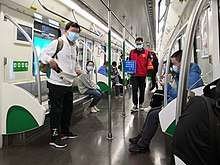
On 23 January 2020, the entire metro network was shut down, along with all other public transport in the city, including national railway and air travel, to halt the spread of COVID-19 pandemic in Hubei.[9][10]
On 28 March 2020, six lines (Line 1, 2, 3, 4, 6, 7) resumed operations, after a two-month lockdown.[11] On 8 April 2020, Line 8 Phase 1 resumed operations.[12] On 22 April 2020, Line 8 Phase 3, Line 11, Yangluo line resumed operations.[13]
Timeline of service expansion
| Segment description | Date opened | Station(s) | # of new stations | Length (km) |
|---|---|---|---|---|
| Phase Ⅰ of Line 1 | 28 July 2004 | Zongguan — Huangpu Road | 10[note 1] | 9.769 |
| Phase Ⅱ of Line 1 | 29 July 2010 | Dongwu Boulevard — Zongguan; Huangpu Road — Dijiao |
16[note 2] | 18.494 |
| Phase Ⅰ of Line 2 | 28 December 2012 | Jinyintan — Optics Valley Square | 21 | 27.152 |
| Phase Ⅰ of Line 4[15] | 28 December 2013 | Wuchang Railway Station — Wuhan Railway Station | 15 | 17.974 |
| Hankou North extension of Line 1 | 28 May 2014 | Dijiao — Hankou North | 3 | 5.555 |
| Phase Ⅱ of Line 4 | 28 December 2014 | Huangjinkou — Wuchang Railway Station | 13 | 15.429 |
| Phase Ⅰ of Line 3[16] | 28 December 2015 | Zhuanyang Boulevard — Hongtu Boulevard | 24 | 29.660 |
| Phase Ⅰ of Line 6 | 28 December 2016[17] | Jinyinhu Park — Dongfeng Motor Corporation | 27 | 35.512 |
| North extension of Line 2[note 3] | Tianhe International Airport — Jinyintan | 7 | 19.957 | |
| Phase Ⅰ of Line 8 | 26 December 2017 | Jintan Road — Liyuan | 12 | 16.204 |
| Yangluo Line | Houhu Boulevard — Jintai | 16 | 34.575 | |
| Jinghe extension of Line 1 | Dongwu Boulevard — Jinghe | 3 | 4.118 | |
| Phase Ⅰ of Line 7 | 1 October 2018[18] | Garden Expo North — Yezhihu | 19 | 30.413 |
| Phase Ⅰ of Line 11 | Optics Valley Railway Station — Zuoling | 13 | 18.744 | |
| South extension of Line 7 | 28 December 2018 | Yezhihu — Qinglongshan Ditiexiaozhen | 7 | 16.550 |
| South extension of Line 2 | 19 February 2019 | Optics Valley Square — Fozuling | 10 | 13.195 |
| West extension of Line 4[19] | 25 September 2019 | Bailin — Huangjinkou | 9 | 16.288 |
| Phase Ⅲ of Line 8[1] | 6 November 2019 | Yezhihu — Military Athletes' Village | 3 | 4.832 |
- in which Taipingyang Station's opening was postponed until 8 April 2006.
- in which Zhuyehai Station's opening was postponed until 17 September 2014.[14]
- also known as Airport Line
Lines
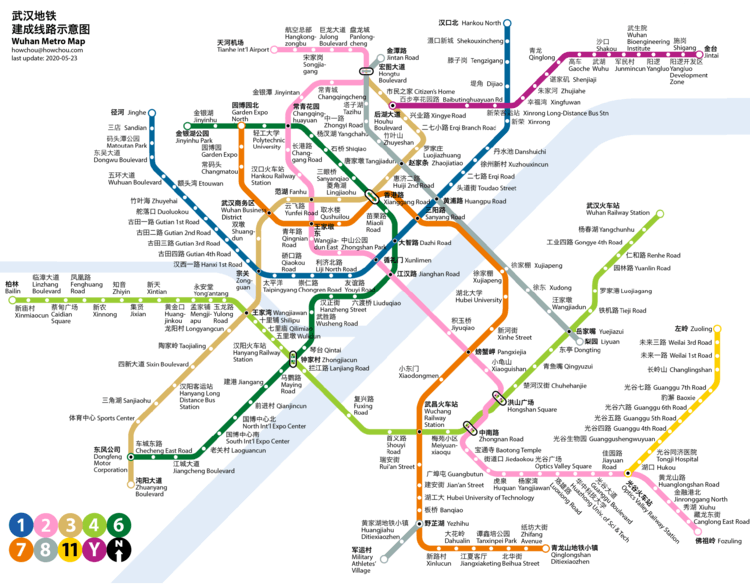
(1) Transfer at Xujiapeng sta. between Line 7 and 8 won't be open until Line 5 comes into operation;
(2) Passagers transferring between Xinrong sta. of Line 1 and Xinrong Long-distance Bus sta. of Yangluo Line have to exit and enter the system again, as the direct transfer passage is still under construction;
(3) Line 8 currently consists of two separate parts. To distinguish the two sections, the longer one opening in 2017 is identified as Line 8 Phase 1; the shorter one opening in 2019 is identified as Line 8 Phase 3. The two parts will be joined by Line 8 Phase 2 by the end of 2020.
| Current system | |||||||||||||||||||||||||||||||||||||||||||||||||||||||||||||||||||||||||||||||||||||||||||||||||||
|---|---|---|---|---|---|---|---|---|---|---|---|---|---|---|---|---|---|---|---|---|---|---|---|---|---|---|---|---|---|---|---|---|---|---|---|---|---|---|---|---|---|---|---|---|---|---|---|---|---|---|---|---|---|---|---|---|---|---|---|---|---|---|---|---|---|---|---|---|---|---|---|---|---|---|---|---|---|---|---|---|---|---|---|---|---|---|---|---|---|---|---|---|---|---|---|---|---|---|---|
| Line Name | Termini | Opened | Last extension | Length[20] | Stations | Layout | |||||||||||||||||||||||||||||||||||||||||||||||||||||||||||||||||||||||||||||||||||||||||||||
| Line 1 | Jinghe | Hankou North | 28 July 2004 | 26 December 2017 | 37.936 km (23.572 mi) | 32 | Elevated | ||||||||||||||||||||||||||||||||||||||||||||||||||||||||||||||||||||||||||||||||||||||||||||
| Line 2 | Tianhe International Airport | Fozuling | 28 December 2012 | 19 February 2019 | 60.304 km (37.471 mi) | 38 | Elevated & underground | ||||||||||||||||||||||||||||||||||||||||||||||||||||||||||||||||||||||||||||||||||||||||||||
| Line 3 | Zhuanyang Boulevard | Hongtu Boulevard | 28 December 2015 | — | 29.660 km (18.430 mi) | 24 | Underground | ||||||||||||||||||||||||||||||||||||||||||||||||||||||||||||||||||||||||||||||||||||||||||||
| Line 4 | Bailin[21] | Wuhan Railway Station | 28 December 2013 | 25 September 2019 | 49.693 km (30.878 mi) | 37 | Elevated & underground | ||||||||||||||||||||||||||||||||||||||||||||||||||||||||||||||||||||||||||||||||||||||||||||
| Line 6 | Jinyinhu Park | Dongfeng Motor Corporation | 28 December 2016 | — | 35.512 km (22.066 mi) | 27 | Underground | ||||||||||||||||||||||||||||||||||||||||||||||||||||||||||||||||||||||||||||||||||||||||||||
| Line 7 | Garden Expo North | Qinglongshan Ditiexiaozhen | 1 October 2018 | 28 December 2018 | 46.963 km (29.181 mi) | 26 | Underground | ||||||||||||||||||||||||||||||||||||||||||||||||||||||||||||||||||||||||||||||||||||||||||||
| Line 8 Phase Ⅰ | Jintan Road | Liyuan | 26 December 2017 | — | 16.204 km (10.069 mi) | 12 | Underground | ||||||||||||||||||||||||||||||||||||||||||||||||||||||||||||||||||||||||||||||||||||||||||||
| Line 8 Phase Ⅲ | Yezhihu | Military Athletes' Village | 6 November 2019 | — | 4.832 km (3.002 mi) | 3 | Underground | ||||||||||||||||||||||||||||||||||||||||||||||||||||||||||||||||||||||||||||||||||||||||||||
| Line 11 | Optics Valley Railway Station | Zuoling | 1 October 2018 | — | 18.744 km (11.647 mi) | 13 | Underground | ||||||||||||||||||||||||||||||||||||||||||||||||||||||||||||||||||||||||||||||||||||||||||||
| Yangluo Line[note 1] | Houhu Boulevard | Jintai | 26 December 2017 | — | 34.575 km (21.484 mi) | 16 | Elevated & underground | ||||||||||||||||||||||||||||||||||||||||||||||||||||||||||||||||||||||||||||||||||||||||||||
| Total | 339 km (211 mi) | 228[note 2] | |||||||||||||||||||||||||||||||||||||||||||||||||||||||||||||||||||||||||||||||||||||||||||||||||
- Yangluo Line is also known as Line 21.
- Transfer stations are counted repeatedly.
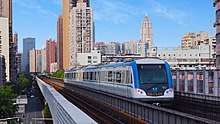
Line 1
Line 1 is a 37.788 km (23.480 mi) elevated urban rail line entirely located in the borough of Hankou. It runs a northwest–southeast route that approximately parallels with Jiefang Avenue for its entire length. There are 27 planned stations, among which 25 are operational. Line 1 operates 33 four-car train sets, 12 of which are manufactured by Changchun Railway Vehicles, and 21 by Zhuzhou Electric Locomotive Co., Ltd.
On July 28, 2004, the first phase of Line 1 began service from Huangpu Road to Zongguan. On July 28, 2010, Line 1 extended from both ends after the completion of phase 2.[22] The phase 3 expansion, which extends the northeast terminus to Hankou North Station, entered revenue service on May 28, 2014.[23] The phase 4 expansion, which extends to Jinghe Station from Dongwu Boulevard. The phase 4 opened on Dec 26th, 2017. Line 1's color is blue.
Line 2
Line 2 is a 27.895 km (17.333 mi) underground subway connecting the boroughs of Hankou and Wuchang. Upon completion, Line 2 was the first subway in China to cross the mighty Yangtze River.[24] It runs in a northwest–southeast route and crosses the Yangtze River near Jianghan Road, and Jiyuqiao in Wuchang. Tunnel drilling concluded on February 26, 2012.[24] Revenue service of Line 2 began on December 28, 2012.[25][26] Line 2 operates 41 six-car train sets, all of which were manufactured by Zhuzhou Electric Locomotive Co., Ltd.
Line 2 is set to be extended towards both directions. The southern extension will bring the southeast terminus from Optics Valley Square to 6th Gaoxin Road, and the northwest extension plan will bring the northwest terminus from Jinyintan to Wuhan Tianhe International Airport, providing convenient access for airport and residential areas en route. Early on, construction work on both extensions was expected to commence in 2013, and the tentative completion dates was set at 2015. In May 2014, it was reported that the construction work on the southern extension would start within 2014, with was the completion by February 19, 2019. Line 2's color is pink.[27]
Line 3
Overall construction of Line 3 was approved by National Development and Reform Commission on Feb 23, 2012,[28] and officially started on Mar 31, 2012.[29] Line 3 went into operation on December 28, 2015. Line 3's color is dark yellow.[16] Line 3 cars are Type B and manufactured by CRRC Changchun Railway Vehicles.
Line 4
Line 4 is mostly underground. It will run in an east–west route serving the Hanyang and Wuchang distincts. The first phase linking Wuchang and Wuhan railway stations opened on December 28, 2013; since that day, all three main railway stations of Wuhan are connected by the Metro. The second phase of Line 4 will crossing the Yangtze River to Hanyang opened in 2014. Line 4's color is light green.[30] Line 4 cars are Type B and manufactured by CRRC Zhuzhou Electric Locomotive.
Line 6
Line 6 opened in 2016.[17] And it is the first line of Wuhan Metro to use high capacity A size trains with overhead lines. Line 6's color is green. Line 6 uses Type A cars manufactured by CRRC Zhuzhou Electric Locomotive.
Line 7
Line 7 is a rapid transit line in Wuhan. The line runs from Garden Expo North in Dongxihu District to Qinglongshan Ditiexiaozhen in Jiangxia District. It serves residential & business areas such as Nanhu, Wuhan CBD and Wuhan Financial street. Line 7 reserves Wuhan Metro's highest capacity rolling stock to date featuring 8 Type-A car train sets accommodating 2480 people, compared to the standard 6 cars found on other lines. It is also the fastest urban line in the system, with trains capable of reaching the speed of 100 km/h (62 mph) compared to 80 km/h (50 mph) on other lines. [31]
Line 8
Line 8 currently consists of two separate parts. Line 8 Phase 1 was opened in 2017, and Line 8 Phase 3 was opened in 2019. Presently there are 12 stations on the Phase 1 section and 3 on the Phase 3 section. The Phase 2 that is under construction will connect the two parts by the end of 2020.
Line 11
Line 11 was opened on 1 October 2018 on National Day. Line 11 uses Type A cars manufactured by CRRC Changchun Railway Vehicles.
Yangluo Line
The Yangluo Line is a rapid transit line that forms part of the Wuhan Metro system. Coloured magenta on the metro map, the line in its current form runs from Houhu Boulevard to Jintai, a total distance of 34.575 km (21.484 mi). The line connects the urban area of Hankou and Yangluo, Xinzhou District.
Services
Service routes
Short turns are used on Line 2, Line 4, and Line 7, while the other lines only operate the full length of the route. As far as Line 2, Line 4, and Line 7 are concerned, the short turns alternate with the full routes.
- Line 2
- Short turn: Jinyintan — Optics Valley Railway Station
- Full route: Tianhe International Airport — Fozuling
- Line 4
- Short turn: Yulong Road — Wuhan Railway Station
- Full route: Bailin — Wuhan Railway Station
- Line 7
- Short turn: Garden Expo North — Banqiao
- Full route: Garden Expo North — Qinglongshan Ditiexiaozhen
Opening hours
The operating hours start at 6:00 on weekdays and 6:30 on weekends & holidays. The last trains of Yangluo Line depart from the terminis at 22:00 or 22:30, while other lines at 23:00. See the table below for more details. [32]
| Line | Weekdays | Weekends and holidays | |
|---|---|---|---|
| Yangluo Line | To Jintai | 6:00 - 22:30 | 6:30 - 22:30 |
| To Houhu Boulevard | 6:00 - 22:00 | 6:30 - 22:00 | |
| Other lines | 6:00 - 23:00 | 6:30 - 23:00 | |
Ticketing
Fares vary based on the distance travelled.[20]
¥2 0 ~ 4 km ¥3 4 ~ 8 km ¥4 8 ~ 12 km ¥5 12 ~ 18 km ¥6 18 ~ 24 km ¥7 24 ~ 32 km ¥8 32 ~ 40 km ¥9 40 ~ 50 km + ¥1
~ +20 km |
Discount
Most Passagers enter and exit the system using a proximity card called Wuhan Tong, which is available at all metro stations. Passagers who pay metro fare with a Wuhan Tong Card can receive a 10% discount.[33]Besides the metro, Passengers can also pay tram, bus, and ferry fees by Wuhan Tong within Wuhan.
Multi-day pass
There are three kinds of multi-day pass cards valid for one, three, and seven days respectively.
- One-day pass: ¥18 each and valid for 1 day;
- Three-day pass: ¥45 each and valid for 3 days;
- Seven-day pass: ¥90 each and valid for 7 days.
Cardholders may enjoy one, three, or seven days of unlimited rides in the metro system. The multi-day pass cards are available at the Customer Service Centres in the metro stations. In addition, a RMB 20 deposit is charged for each multi-day pass card.
.jpg) Wuhan Metro introduced QR code payment across the whole network.
Wuhan Metro introduced QR code payment across the whole network. Single journey ticket
Single journey ticket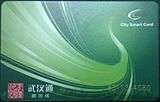 Wuhan Tong Card
Wuhan Tong Card Ticket vending machines
Ticket vending machines.jpg) Faregates
Faregates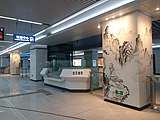 Customer service center
Customer service center
Amenities
.jpg)
4G LTE services are provided in all stations and trains. As Line 1 was put into operation earlier, it lacks in some facilities. For more amenity information, plsease see the table below. It is worth mentioning that most of the restrooms are set outside the paid area.
| Station | Restroom | Lift | |
|---|---|---|---|
| Stations on Line 1 | Youyi Road, Liji North Road, Chongren Road, Qiaokou Road, Taipingyang Station |
unavailable | unequipped |
| Huangpu Road, Sanyang Road, Dazhi Road, Xunlimen, Zongguan Station[34] |
available | unequipped | |
| The rest | available | equipped | |
| Stations on other lines | available | equipped | |
Rolling stock
 Line 1
Line 1.jpg) Line 2
Line 2 Line 3
Line 3 Line 4
Line 4 Line 6
Line 6 Line 7
Line 7.jpg) Line 8
Line 8.jpg) Line 11
Line 11.jpg) Yangluo Line
Yangluo Line.jpg) Train interior of Line 7
Train interior of Line 7.jpg) Train interior of Line 11
Train interior of Line 11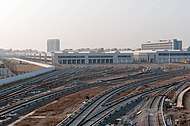 Sanjintan Depot, Line 8
Sanjintan Depot, Line 8
Signalling
Wuhan Metro Line 1 is the first one equipped with moving block system in China.[35] All the lines are equipped with CBTC. In the future, a fully automated, driverless train system (GoA4), provided by Traffic Control Technology Corporation Limited, will be applied to Line 5.[36][37]
Ridership
.jpg)
.jpg)
Since 2012, the ridership of the entire network has grown because there are new lines or sections coming into operation every year. The following data were published by the Wuhan Statistics Bureau, however, the data before 2007 are unavailable.
| Year | Ridership (in million) |
|---|---|
| 2007[38] | 9.26 |
| 2008[38] | 11.06(+19.44%) |
| 2009[39] | 13.17(+19.08%) |
| 2010[40] | 33.00(+150.57%) |
| 2011[41] | 77.37(+134.45%) |
| 2012[42] | 82.88(+7.12%) |
| 2013[43] | 273.43(+229.91%) |
| 2014[44] | 356.24(+30.29%) |
| 2015[45] | 565.10(+58.63%) |
| 2016[46] | 716.59(+26.81%) |
| 2017[47] | 926.83(+29.34%) |
| 2018[48] | 1,040.54(+12.27%) |
| 2019[49] | 1,229.03(+18.11%) |
Future expansion
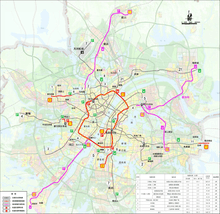
A number of lines are under construction. Line 12 will be a loop line. Line 5 is proposed to use automated driverless trains.[50] Line 9, 10, as well as Line 13, are being planned by the municipal authority.[51]
| Lines and Liveries | Termini | Expected to open | Total Length in km |
Stations | Status | |
|---|---|---|---|---|---|---|
| Phase Ⅱ of Line 6 | Zoumaling | Jinyinhu Park | 2020 | 15.3 | 9 | Under construction |
| Phase Ⅱ of Line 8 | Liyuan | Yezhihu | 2020 | 17.4 | 11 | Under construction |
| Phase Ⅱ of Line 11 | Wuchang Railway Station | Optics Valley Railway Station | 2021 | 12.41 | 7 | Under construction |
| Phase Ⅲ of Line 11 | Zuoling | Gedian South Railway Station (in Ezhou city) | 2020 | 3.7 | 1 | Under construction |
| Huangjinkou | Xinhanyang Railway Station | TBD | 2.2 | 2 | Approved | |
| Jiang'an Road | Wuchang Railway Station | TBD | 4 | 2 | Under construction | |
| Line 5 | South Third Ring Road | Wuhan Railway Station | 2021 | 33.57 | 25 | Under construction |
| Line 16 | South International Expo Center | Zhoujiahe | 2021 | 32.4 | 12 | Under construction |
| Line 12 | loop line | 2023 | 60.4 | 35 | Under construction | |
| Line 19 | Wuhan Railway Station | Optics Valley Free Trade Zone | 2023 | 24.45 | 9 | Under construction |
| North extension of Line 7 | Machi | Huangpi Square | 2024 | 36 | 10 | Under construction |
| Xingang Line | Wuhan Railway Station | Shigang | 2025 | 26.2 | 10 | Approved |
| Line 10 | Changfu | Wuhan Railway Station | TBD | 61.4 | 29 | Proposed |
| Phase Ⅱ of Yangluo Line | Zhongyi Road | Houhu Boulevard | TBD | 3.2 | 2 | Proposed |
| Line 13 | New Hanyang Railway Station | Future Tech-city | TBD | 40.4 | 27 | Proposed |
| Line 14 | Zhuyehai | Dijiao | TBD | 27.2 | 21 | Proposed |
| Line 20 | Tianhe International Airport | Wuhan Railway Station | TBD | 30.3 | 6 | Proposed |
Station
Almost all stations, except the stations on Line 1, are equipped with platform screen doors. There is a plan that stations on Line 1 will be equipped with platform screen doors in the future.[52][53] The metro stations are equipped to be disabled and elderly friendly, with automatic fare collection system, announcement system, electronic display boards, escalators and lifts. The stations are equipped with non-slippery flooring with grip-rails, audio announcements and Braille facilities to help visually challenged passengers.
Gallery
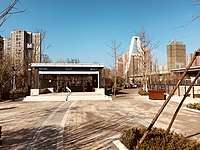 Station entrance
Station entrance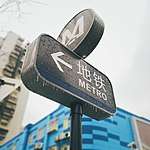 Guidepost
Guidepost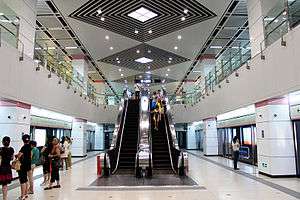 Zhongshan Park Station
Zhongshan Park Station The concourse of Wuhan Business District Station
The concourse of Wuhan Business District Station.jpg) The concourse of Huangpu Road Station, Line 8
The concourse of Huangpu Road Station, Line 8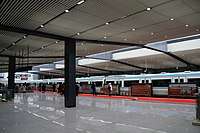 The widened platform of Huangpu Road Station, Line 1
The widened platform of Huangpu Road Station, Line 1.jpg) The platform of Pangxiejia Station, Line 7
The platform of Pangxiejia Station, Line 7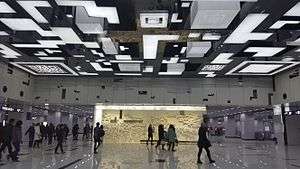 The concourse of Wangjiawan Station
The concourse of Wangjiawan Station_02.jpg) Tianhe International Airport Station
Tianhe International Airport Station.jpg) The platform of Xujiapeng Station, Line 8
The platform of Xujiapeng Station, Line 8.jpg) Transfer passage in Sanyang Road Station
Transfer passage in Sanyang Road Station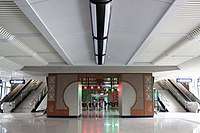 The concourse of Matoutan Park Station
The concourse of Matoutan Park Station The concourse of Luoxiong Road Station
The concourse of Luoxiong Road Station.jpg) The concourse of Hanzheng Street Station
The concourse of Hanzheng Street Station The platform of Hanzheng Street Station
The platform of Hanzheng Street Station Continuous cross-platform transfer on Line 2 & 4
Continuous cross-platform transfer on Line 2 & 4
| Wikimedia Commons has media related to Stations of Wuhan Metro. |
See also
Notes
- Transfer stations are counted more than once. There are 23 two-line transfer stations and 2 three-line transfer stations. If transfer stations are counted only once, the result will be 201 stations.
References
- "明日9点,武汉轨道交通8号线三期工程开通试运营". Wuhan Metro Operation. 2019-11-05.
- WeChat@地铁客流及运输研究阿牛 (2020-02-15). 全来了!2019年中国城市地铁客运量总结. 中国城市轨道交通协会.
- 武汉地铁清明小长假送客1615万乘次,客流量42天内三创纪录.
- "> Asia > China > Wuhan Metro". UrbanRail.Net. Archived from the original on April 9, 2010. Retrieved April 21, 2010.
- "今后五年 每年开通两条地铁线". 武汉晨报. 2015-12-28.
- 轻轨二期增设竹叶海站 (in Chinese).
- 武汉轻轨票价下调 (in Chinese).
- 武汉轻轨客流量今日突破1亿 (in Chinese).
- "Public Transport In Wuhan Suspended Due To Coronavirus Concerns". NPR.org. Retrieved 2020-01-23.
- "Virus-hit Chinese city shuts public transport". BBC News. 2020-01-23. Retrieved 2020-01-23.
- "Wuhan buses hit the road after two-month lockdown". Xinhua. Retrieved 2020-03-25.
- Huang Lei;Wang Yang (2020-04-07). "武汉:4月8日起恢复出租车运营 适时恢复网约车运营". Hubei Daily.
- "8号线三期、11号线、阳逻线恢复运营,22日起,武汉地铁全线网恢复正常". 2020-04-21.
- 轻轨竹叶海站宜家联廊桥投入使用 (Zhuyehai station opened)
- Section one of Metro Line 4 opens
- 武汉即将地铁成环 "环金时代"重构商业地理. 长江日报 (in Chinese). 2015-12-24. Retrieved 2015-12-24.
- 武汉地铁机场线及6号线今日开通 湖北移动全面布局网络覆盖
- 武汉长江公铁隧道今日开通 7号线、11号线试运营. www.xinhuanet.com. Retrieved 2017-12-26.
- "定了!地铁蔡甸线25日上午9时开通". 2019-09-23.
- "Ticketing regulations". Wuhan Metro Group Co., Ltd. 2019-11-05.
- "被调侃开往德国 武汉地铁柏林站注音改为"bailin"". 2019-10-04.
- "Wuhan light rail starts test run". China Daily. Retrieved 2010-07-31.
- 武汉地铁1号线汉口北延长线明日开通 (in Chinese).
- "Subway to cross under Yangtze". Retrieved March 5, 2012.
- 今日10时武汉地铁2号线开通 武汉迈入地铁时代(图) (in Chinese). Retrieved December 28, 2012.
- "Subway ticket price hearing held". Retrieved October 29, 2012.
- Nowadays, Line 2 only have 6 cars, but in the future, it is possible to add 2 cars to carry more people when the population of passengers are growing up, and 6 cars are not enough. 年内开工2019年通车 武汉地铁2号线南延线公布十站点 (Work starting within this year; service opening in 2019. Ten stations announced for the Southern Extension of Line 2 of Wuhan Metro), 2014-05-28
- 武汉地铁3号线获国家发改委批复 一期下月全面开工. Retrieved February 23, 2012.
- 武汉地铁3号线今天正式动建 首穿汉江江底. Retrieved March 30, 2012.
- 地鐵4號綫二期12月28日試運營 結束漢陽無地鐵歷史 (in Chinese). 荊楚網. Retrieved 2014-12-11.
- http://en.hubei.gov.cn/news/newslist/201608/t20160812_881297.shtml
- "运营时刻表".
- "武汉地铁除普通卡票价9折优惠外还上调奖励金额". 2019-07-29.
- The restroom is located in Station Hall of another line but shared by the two lines because it is an interchange station.
- "15年了,武汉人越来越离不开TA!你还记得第一次吗?". 长江日报. 2019-07-17.
1号线是国内首条采用移动闭塞信号系统线路
- "武汉地铁5号线有望取消驾驶室,实现真正无人驾驶!". 武汉地铁. 2017-08-03.
- Gong Ping; Liu Dandan; Yuan Yonghua (2020-05-31). ""武汉造"全自动无人驾驶地铁列车来啦!不设驾驶室,还有这些"高精尖"". 长江网. Archived from the original on 2020-05-31.CS1 maint: multiple names: authors list (link)
- Wuhan Statistics Bureau. Wuhan Statistical Yearbook-2009.
- Wuhan Statistics Bureau (August 2010). Wuhan Statistical Yearbook-2010 (PDF) (in Chinese). Beijing, China: China Statistics Press. p. 167. ISBN 978-7-5037-6013-6.
- Wuhan Statistics Bureau (August 2011). Wuhan Statistical Yearbook-2011 (PDF) (in Chinese). Beijing, China: China Statistics Press. p. 203. ISBN 978-7-5037-6309-0.
- Wuhan Statistics Bureau (September 2012). Wuhan Statistical Yearbook-2012 (PDF) (in Chinese). Beijing, China: China Statistics Press. p. 175. ISBN 978-7-5037-6650-3.
- Wuhan Statistics Bureau (September 2013). Wuhan Statistical Yearbook-2013 (PDF) (in Chinese). Beijing, China: China Statistics Press. p. 167. ISBN 978-7-5037-6922-1.
- Wuhan Statistics Bureau (September 2014). Wuhan Statistical Yearbook-2014 (PDF) (in Chinese). Beijing, China: China Statistics Press. p. 161. ISBN 978-7-216-06726-3.
- Wuhan Statistics Bureau (September 2015). Wuhan Statistical Yearbook-2015 (PDF) (in Chinese). Beijing, China: China Statistics Press. p. 183. ISBN 978-7-5037-7570-3.
- Wuhan Statistics Bureau (September 2016). Wuhan Statistical Yearbook-2016 (PDF) (in Chinese). Beijing, China: China Statistics Press. p. 157. ISBN 978-7-5037-7913-8.
- Wuhan Statistics Bureau (August 2017). Wuhan Statistical Yearbook-2017 (PDF) (in Chinese). Beijing, China: China Statistics Press. p. 149. ISBN 978-7-5037-8197-1.
- Wuhan Statistics Bureau (August 2018). Wuhan Statistical Yearbook-2018 (PDF) (in Chinese). Beijing, China: China Statistics Press. p. 149. ISBN 978-7-5037-8523-8.
- "2018年武汉市国民经济和社会发展统计公报" (in Chinese). Wuhan Statistics Bureau. 2019-03-26.
- "2019年武汉市国民经济和社会发展统计公报" (in Chinese). Wuhan Statistics Bureau. 2020-03-29.
- 中新网湖北 湖北新闻网 武汉地铁进入全自动驾驶时代 5号线有望"尝鲜". www.hb.chinanews.com. Retrieved 2018-05-21.
- 十二五期间,武汉将投资491亿新建远城区8条轨道交通 (in Chinese). Retrieved 2012-05-01.
- 陶常宁;胡琴 (2015-05-04). "武汉地铁1号线将全线安装站台安全门 与循礼门站一致". 武汉晨报.
- 刘孝斌;黄士峰 (2016-01-06). "武汉女乘客意外跌下1号线站台 轻轨安全门迟迟不装". 楚天都市报.
External links
| Wikimedia Commons has media related to Wuhan Metro. |
- Official site (in Chinese)
- UrbanRail.net's page on the Wuhan Metro
